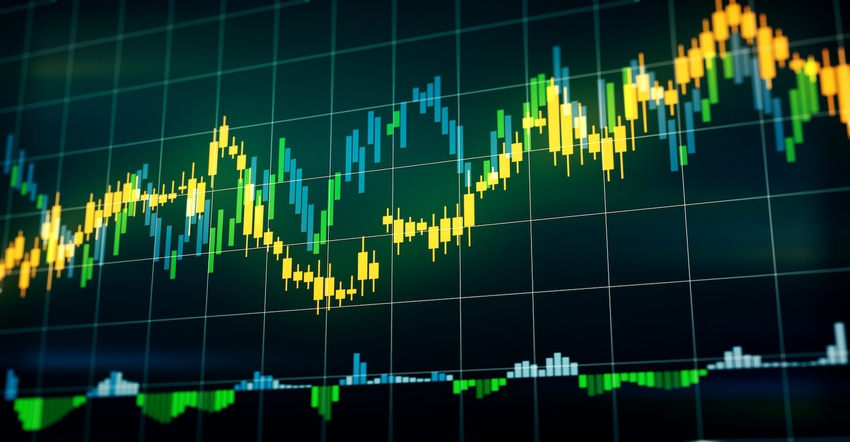Producers are under pressure to discount material, as upstream inventories remain near record levels.
June 1, 2022

Resin trading was a bit slower the final full week of May, as most market participants seemed to take early leave for the long Memorial Day weekend. Short-term resin pricing has taken on a bit of a negative tone after losing its upward momentum a month ago, reports the PlasticsExchange in its Market Update. Ongoing geopolitical issues, high commodity prices, inflation, and continued COVID shutdowns in China have been weighing on market sentiment.
Polyethylene (PE) offers were more available last week, both export and domestic, and spot prices eased about $0.03/lb. The pullback occurred as producers appeared unable to implement any of their $0.06 to 0.07/lb price increase for May contracts. Producers are digging in, however, and contracts are not settled. Spot polypropylene (PP) prices also came off $0.03/lb, as monomer costs remained weak and off-grade railcars were plentiful into the end of the month. May PP contracts seem to be settling down a net $0.07/lb, as a result of a $0.10/lb decrease in May PGP contracts, while PP producers are earning an offsetting $0.03/lb margin-enhancing increase, just half of what they wanted. Both PE and PP producers will try to implement more increases in June.
The energy complex continued strong, inspired by ongoing supply concerns because of the conflict in Eastern Europe and the upcoming driving season in the United States. West Texas Intermediate (WTI), one of the three major oil benchmarks, rallied for a fifth consecutive week, while Brent prices surged even more to re-establish a nice premium to WTI. Nat Gas jumped for a second straight week, surpassing $9/mmBtu in the process. The extended rally has been powered by global export demand for liquefied natural gas and AC cooling demand in the United States.
PE activity slowdown results in sizable price erosion
The slowdown in PE activity also brought with it a decline in completed volumes at the PlasticsExchange and a sizable drop in prices, with losses reaching $0.03/lb. However, high-density (HD) PE sales still picked up considerably for Blow Mold and Injection grades, a reversal of the previous week’s dismal showing of activity and completed business. This time around it was linear-low-density (LLD) and low-density (LD) PE transactions that could not keep pace, as business was mostly held to LLDPE Film and LDPE Injection. May contracts seem poised to roll flat again, as processors hope to stave off a $0.06 to 0.07/lb increase for a second month. Producers have yet to acquiesce and are digging in for at least $0.03/lb. They should have done this a month ago, when the market was actually up, writes the PlasticsExchange.
The PE market had maintained a steady upward bias since the beginning of January but then stalled in late April when PE producers were surprisingly unable to secure any of the $0.06 to 0.07/lb price increase that was on the table. Last week brought the biggest decline in pricing so far this year, reports the PlasticsExchange. Producers remain under pressure to discount material, especially for incremental exports, as collective upstream inventories remain near record levels despite a slowdown in production. Houston warehouses are still packed to the gills and one new major producer will enter the market with fresh production capacity over the next two months.
Spot homo-polymer PP drops below dollar-per-pound level
PP demand was muted, as confirmed transactions through the PlasticsExchange marketplace were limited to those seeking material to tide them over from late railcar deliveries. Just a few deals resulted from the normal order flow. Spot prices pulled back as the May PP decrease is coming in on the heftier side of the range. The decline brought spot homo-polymer PP below the $1.00/lb level for the first time since early March, while co-polymer PP maintained its dime premium. PP prices were also on a consistent upward trend since the beginning of the year, right up until late April when resin reactors were throttled back, stunting demand for feedstock monomer, sending PGP prices sharply lower.
Traders have been cautious, as downward pricing pressure has set in from ample inventory, lower feedstock monomer costs, and declining freight costs, which have prompted some fresh imports. And much like in the PE market, new PP production capacity is expected to come online soon, but out of Canada rather than the US Gulf. PP producers are looking to offset the downward fundamental pressure and will continue to push for an additional margin-enhancing increase to pad current levels before new production hits the market. Without any significant event impacting production, resin producers have little, if any, support behind price increase nominations, according to the PlasticsExchange. It may take an above-average hurricane season to keep resin pricing from seeing a significant drop.
Another above-average hurricane season?
In its outlook for the 2022 Atlantic hurricane season, the National Oceanic and Atmospheric Administration (NOAA) predicted a 65% chance of an above-normal season, a 25% chance of a near-normal season, and a 10% chance of a below-normal season. The forecast also calls for a likely range of 14 to 21 named storms, six to 10 of which could become hurricanes. Three to six of them could be major Category 3, 4, or 5 hurricanes with winds of 111 mph or higher. Should the 2022 hurricane season develop as forecast, it would be the seventh consecutive above-average hurricane season.
Read the full Market Update, including news about PGP pricing and energy futures, on the PlasticsExchange website.
You May Also Like


